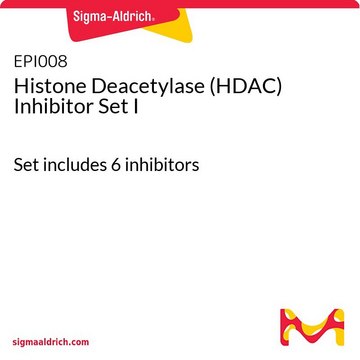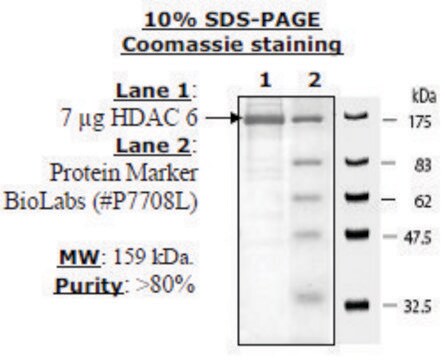CS1010
Histone Deacetylase Assay Kit, Fluorometric
sufficient for 100 assays (96 well plates)
Synonyme(s) :
HDAC Assay Kit
Se connecterpour consulter vos tarifs contractuels et ceux de votre entreprise/organisme
About This Item
Produits recommandés
Utilisation
sufficient for 100 assays (96 well plates)
Niveau de qualité
Conditions d'expédition
dry ice
Température de stockage
−20°C
Informations sur le gène
human ... HDAC1(3065)
Application
The Histone Deacetylase Assay Kit provides a simple method for the detection of HDAC activity based on a two-step enzymatic reaction. The substrate for this enzymatic assay is a substituted peptide with an acetylated lysine residue and a bound fluorescent group. The first step of the reaction is deacetylation of the acetylated lysine side chain by the HDAC containing sample (HeLa cell extract, purified enzyme, etc.). The second step is the cleavage of the deacetylated substrate by the developer solution and the release of the free highly fluorescent group. The measured fluorescence is directly proportional to the deacetylation activity of the sample.
Actions biochimiques/physiologiques
Histone deacetylases (HDACs) are enzymes that remove acetyl groups from histone proteins. HDACs are important regulators of gene expression and genome function. They are implicated in a number of human disease states, namely several cancers, neurological disorders, and aging. Therefore, HDAC are relevant key targets for therapeutic intervention. Moreover, histone deacetylase inhibitors have been shown to serve as anti-tumor agents.
Caractéristiques et avantages
The kit includes all the reagents required for the fast and easy measurement of HDAC activity in cell or nuclear extracts, or with purified enzyme preparations. In addition, the kit provides HeLa cell lysate as a source of HDAC activity for inhibitor screening or as a positive control, a HDAC inhibitor (Trichostatin A), and a standard to enable activity quantitation.
Remarque sur l'analyse
The Histone Deacetylase Assay Kit has been tested on HeLa, HEK 293T, NIH 3T3, and U 973 cell extracts.
Composants de kit seuls
Réf. du produit
Description
- Assay Buffer 20 mL
- Developer Solution 1.5 mL
- HDAC Inhibitor (Trichostatin A), 1 mM 50 μL
- HDAC Substrate, 20 mM 50 μL
- HeLa Cell Lysate 500 μL
- Standard (non-acetylated substrate), 4 mM 50 μL
Code de la classe de stockage
10 - Combustible liquids
Point d'éclair (°F)
188.6 °F - closed cup
Point d'éclair (°C)
87 °C - closed cup
Faites votre choix parmi les versions les plus récentes :
Déjà en possession de ce produit ?
Retrouvez la documentation relative aux produits que vous avez récemment achetés dans la Bibliothèque de documents.
Les clients ont également consulté
Bartosz Bieszczad et al.
Pharmaceuticals (Basel, Switzerland), 14(9) (2021-09-29)
Histone deacetylase (HDAC) inhibitors are a class of drugs used in the cancer treatment. Here, we developed a library of 19 analogues of Vorinostat, an HDAC inhibitor used in lymphomas treatment. In Vorinostat, we replaced the hydrophobic phenyl group with
Lin Du et al.
Journal of natural products, 77(7), 1753-1757 (2014-07-08)
The cyclic tetrapeptide 1-alaninechlamydocin was purified from a Great Lakes-derived fungal isolate identified as a Tolypocladium sp. Although the planar structure was previously described, a detailed analysis of its spectroscopic data and biological activity are reported here for the first
Jason D Plummer et al.
eLife, 10 (2021-03-31)
Methionine restriction (MR) dramatically extends the healthspan of several organisms. Methionine-restricted rodents have less age-related pathology and increased longevity as compared with controls, and recent studies suggest that humans might benefit similarly. Mechanistically, it is likely that the decreased IGF-1
Articles
Epigenetic modifications are thought to occur through two key interconnected processes—DNA methylation and the covalent modification of histones.
Notre équipe de scientifiques dispose d'une expérience dans tous les secteurs de la recherche, notamment en sciences de la vie, science des matériaux, synthèse chimique, chromatographie, analyse et dans de nombreux autres domaines..
Contacter notre Service technique







